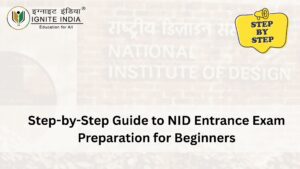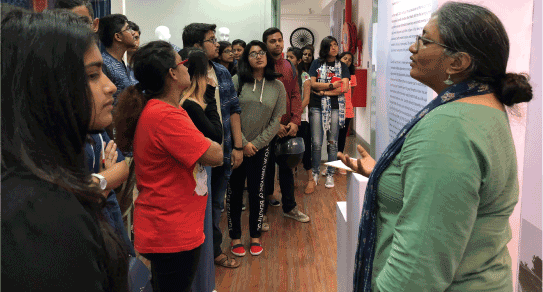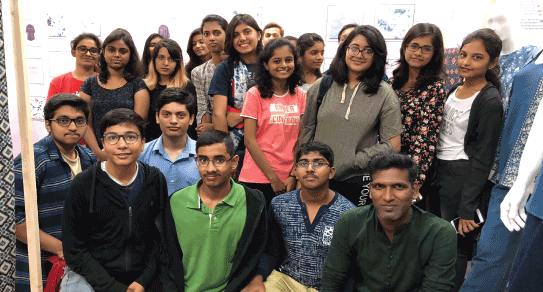
How to Choose the Right NIFT Campus in India: Ranking and Specializations
Getting into NIFT is a big achievement for any fashion and design aspirant. Once the results are out, the biggest question students face is how

The NID Studio Test is one of the most critical stages in securing admission to the National Institute of Design (NID). If you’ve cleared the prelims, congratulations! Now it’s time to focus on acing the studio test, which evaluates your creativity, problem-solving skills, and ability to think out of the box. In this article, we’ll break down essential tips and strategies to help you prepare and stand out.
Understanding the NID Studio Test
The NID Studio Test is a hands-on assessment designed to gauge your creativity and practical abilities. It usually includes tasks like:
Model Making: Creating physical models using materials provided on the spot.
Sketching and Doodling: Illustrating ideas quickly and effectively.
Logical Problem Solving: Tackling design-related puzzles or problems.
Audio-Visual Sensitivity: Tests involving sound, visual interpretation, and storytelling.
Group Discussions or Presentations: Articulating your thought process clearly.
Preparation Tips for NID Studio Test 2025-2026
Practice brainstorming new ideas daily.
Solve design puzzles, riddles, or challenges to enhance your creativity.
Work on projects that require innovation—like creating functional objects from household items.
Familiarize yourself with common materials such as clay, paper, cardboard, and wire.
Learn techniques like cutting, shaping, joining, and finishing.
Practice creating different types of models (abstract, realistic, and functional).
Sketch daily to refine your hand-drawing skills and speed.
Focus on perspective, proportions, and shading.
Learn to visually communicate ideas in minimal time.
Read design blogs and watch design-centric videos.
Analyze innovative products and think about their functionality and aesthetics.
Practice explaining your thought process behind designs.
Join group discussions to build confidence in articulating ideas clearly.
Set time limits for tasks to simulate real exam conditions.
Prioritize steps in your process to complete projects efficiently.
Materials You Should Practice With
Paper and cardboard
Clay and playdough
Wire and thread
Fevicol or glue gun
Popsicle sticks and toothpicks
Fabric and ribbons
On the Day of the Test
Stay Calm: Stress can limit creativity. Take a deep breath and approach tasks methodically.
Read Instructions Carefully: Misinterpreting instructions can cost you crucial points.
Show Your Process: Examiners value seeing your thought process. Include sketches, notes, or explanations where appropriate.
Be Original: Avoid clichés; focus on creating unique and thoughtful designs.
Work Neatly: Presentation matters. Keep your workspace and final product tidy.
Common Mistakes to Avoid
Overthinking the Task: Stick to simple, workable ideas.
Ignoring Time Limits: Allocate time to each aspect of your project.
Using Too Many Materials: Prioritize quality over complexity.
Neglecting to Explain Ideas: Ensure your concept is easily understood.
Frequently Asked Questions (FAQs)
Q1: What is the NID Studio Test?
A: The NID Studio Test is the second stage of the NID admission process, where candidates perform hands-on tasks to showcase their creativity, design aptitude, and problem-solving skills.
Q2: What materials are allowed in the NID Studio Test?
A: While most materials are provided at the test center, practice using commonly available items like clay, paper, cardboard, and glue.
Q3: How can I improve my model-making skills for the test?
A: Ignite India Education is the best place for Practice building models with diverse materials, focus on neatness, and challenge yourself with creative tasks.
Q4: Are group discussions part of the studio test?
A: Some years include group discussions or presentations to evaluate communication skills. Be prepared to articulate your ideas confidently.
Q5: Is sketching necessary for the NID Studio Test?
A: Yes, sketching is often required to illustrate ideas or support your designs.
Q6: How should I present my work during the studio test?
A: Keep it clean, structured, and ensure your thought process is visible through notes or annotations.
Q7: Can I prepare for the studio test without coaching?
A: Absolutely. With the Ignite India Education materials, consistent practice, and creativity, self-preparation can be highly effective.
Q8: How important is creativity in the studio test?
A: Creativity is crucial. Focus on originality and providing practical, innovative solutions.
Q9: What happens if my model isn’t perfect?
A: The examiners value your idea and approach more than perfection. Showcase your concept clearly.
Q10: How can I manage time effectively during the test?
A: Divide your time between planning, execution, and finishing. Stick to a schedule and avoid spending too much time on one task.
Final Words
Cracking the NID Studio Test requires not just creativity but also strategic preparation and confidence. With the right practice, mindset, and resources, you can excel and secure admission to one of the most prestigious design institutes in India. Ignite India Education is here to support your journey with expert guidance and tailored resources.
Start preparing today, think outside the box, and remember—your unique perspective is your greatest strength. Best of luck!
Disclaimer:
This blog post is not an official representation of the National Institute of Fashion Technology (NIFT). The content provided is for informational purposes only and is based on available resources and our previous teaching experience. Readers are advised to conduct their own research and verify information through the official NIFT website for the most authentic information.
Keep an eye on the official NIFT website around September-October 2024 for updates.
IGNITE INDIA EDUCATION Best Coaching for NIFT NID NATA UCEED CEED CLAT
Head Office – 1658, 1st Floor, 27th Main, Sector 2, HSR Layout, Bangalore – 560102
For further information about coaching classes and college admissions, please do not hesitate to contact us at 8884544480.
Ignite India Education, a pioneer in coaching for various design, architecture and management entrance exams, is committed to nurturing the talents of the youth, shaping their futures, and contributing to the nation’s growth. Founded in 2006, Ignite India Education has consistently ranked as a premier coaching institution.


Getting into NIFT is a big achievement for any fashion and design aspirant. Once the results are out, the biggest question students face is how

Preparing for the NIFT entrance exam is a big step for any student who wants to enter the world of design and fashion. Many students

Choosing the right design college is not only about selecting a stream like fashion, product, animation, or communication design. It is also about understanding the

Fashion design has become one of the most exciting and creative fields today. Many students dream of learning fashion, drawing ideas, understanding fabrics, and creating

The Bachelor of Business Administration (BBA) is a popular undergraduate course for students aspiring to pursue a career in business management. With a rapidly evolving

The National Aptitude Test in Architecture (NATA) is one of the most important exams for students aiming to pursue a career in architecture. Whether you



By signing up for IgniteIndia. You agree to the Terms of Services and PrivacyPolicy of the platform.

Preparing for the NID entrance exam can feel confusing when you are just starting. Many students know they want to study design, but they are

Choosing the right master’s degree can shape not just your career, but your entire future. For students who want strong career growth along with good

Getting into NIFT is a big achievement for any fashion and design aspirant. Once the results are out, the biggest question students face is how

Preparing for the NIFT entrance exam is a big step for any student who wants to enter the world of design and fashion. Many students

Choosing the right design college is not only about selecting a stream like fashion, product, animation, or communication design. It is also about understanding the

Fashion design has become one of the most exciting and creative fields today. Many students dream of learning fashion, drawing ideas, understanding fabrics, and creating
Fashion Designer, Educational and Career Counselor. He is an alumnus of NIFT and won the Best Graduation Project Award. He is guiding students from the past 15 years.
Fashion & Textile Designer, Educational and Career Counselor. He is an alumnus of NIFT and won the Best Graduation Project Award. He is guiding students from the past 10 years.
Ignite India Education is inspired by the former President of India Bharat Ratna Dr. APJ Abdul Kalam’s vision of “India Beyond 2020”. Our aim is to fulfil his vision by empowering society and transforming India into a developed nation through education.
Ignite India Education is inspired by the former President of India Bharat Ratna Dr. APJ Abdul Kalam’s vision of “India Beyond 2020”. Our aim is to fulfil his vision by empowering society and transforming India into a developed nation through education.
Fashion Designer, Educational and Career Counselor. He is an alumnus of NIFT and won the Best Graduation Project Award. He is guiding students from the past 15 years.
Fashion & Textile Designer, Educational and Career Counselor. He is an alumnus of NIFT and won the Best Graduation Project Award. He is guiding students from the past 10 years.
Ignite India Education is inspired by the former President of India Bharat Ratna Dr. APJ Abdul Kalam’s vision of “India Beyond 2020”. Our aim is to fulfil his vision by empowering society and transforming India into a developed nation through education.
Fashion & Textile Designer, Educational and Career Counselor. He is an alumnus of NIFT and won the Best Graduation Project Award. He is guiding students from the past 10 years.








Ignite India Alumni networks provide the long-term value to an educational institution by giving alumni the chance to stay in contact and continue to learn from each other long after they have left Institute. Ignite India is a Well Known Design Institute that equips students for success in career.
